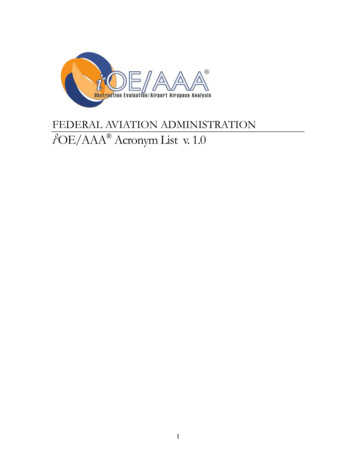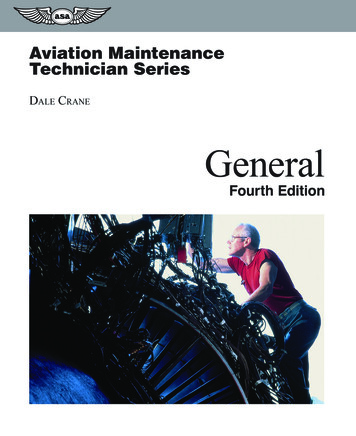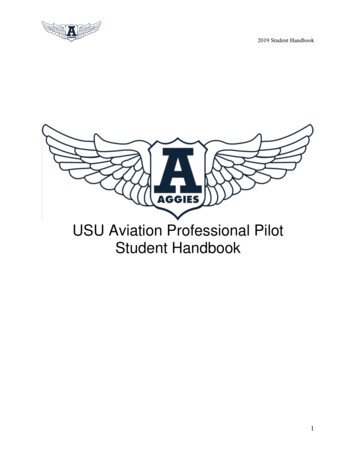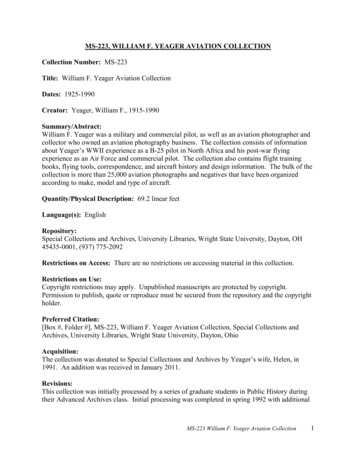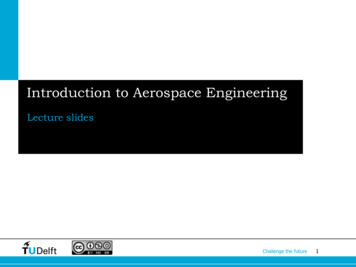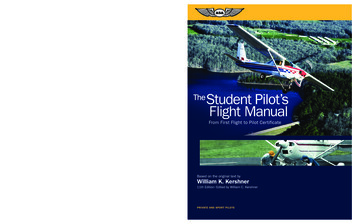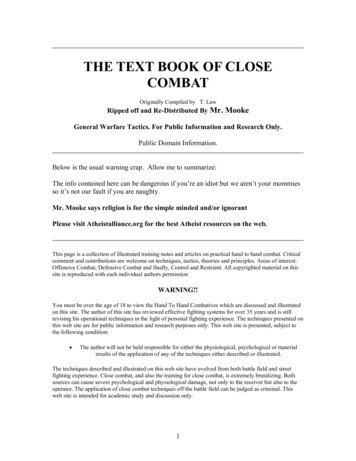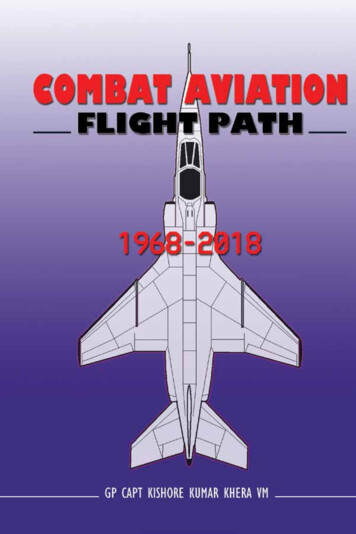
Transcription
COMBAT AVIATIONFlight Path 1968-2018
COMBAT AVIATIONFlight Path 1968-2018Kishore Kumar KheraKNOWLEDGE WORLDKW Publishers Pvt LtdNew Delhi
Copyright 2020 Manohar Parrikar Institute for Defence Studies and Analyses,New DelhiAll rights reserved. No part of this publication may be reproduced, stored in a retrievalsystem, or transmitted, in any form or by any means, electronic, mechanical, photocopying,recording, or otherwise, without first obtaining written permission of the copyright owner.Disclaimer: The views expressed in this book are those of the author(s) and do notnecessarily reflect those of the Manohar Parrikar Institute for Defence Studies andAnalyses, or the Government of India.Manohar Parrikar Institute for Defence Studies and AnalysesNo. 1, Development Enclave, Delhi Cantt.New Delhi-110 010Phone: 91-11-26717983Website: www.idsa.inISBN978-93-89137-44-6 HardbackPublished in India by Kalpana ShuklaKW Publishers Pvt Ltd4676/21, First Floor, Ansari RoadDaryaganj, New Delhi 110 002Phone: 91 11 23263498/43528107Marketing: kw@kwpub.comEditorial: production@kwpub.comWebsite:www.kwpub.comPrinted and bound in IndiaThe content of this book is the sole expression and opinion of its author(s), and not ofthe publisher. The publisher in no manner is liable for any opinion or views expressedby the author(s). While best efforts have been made in preparing the book, the publishermakes no representations or warranties of any kind and assumes no liabilities of any kindwith respect to the accuracy or completeness of the content and specifically disclaims anyimplied warranties of merchantability or fitness of use of a particular purpose.The publisher believes that the contents of this book do not violate any existingcopyright/intellectual property of others in any manner whatsoever. However, in case anysource has not been duly attributed, the publisher may be notified in writing for necessaryaction.
Dedicated toMy Parentsfor giving me my life,My Parents-in-lawsfor giving me my wife;My Wifefor giving meaning to my life,My Childrenfor always supporting my wife.
ContentsList of Figures, Tables and Maps ixAcknowledgements xiiiAbbreviations xivIntroduction: Flight Plan xxPart I Facets of Combat Aviation1. Start, Taxy and Take Off 2. Scanning Rear Airspace: Historical Perspective ofCombat Aviation 3173. Mission Plan: Imperatives of Combat Aviation Application 33Part II Five Decades Trajectory of Combat Aviation 1968-20184. Cruise Climb – Range Descent: Combat AircraftInventory (1968-2018) 515. Changing Mission Profile: Technological Innovationsin Combat Aviation 716. Trigger Live: Air-Launched Weapons: ExpandingCapabilities of Combat Aviation 937. Mission Buddies: Evolving Alternatives andCombat Enablers 1168. Top View: Mapping Combat Aircraft Inventory 151
viii COMBAT AVIATION: Flight Path 1968-2018Part III Dynamics of Combat Aviation9. Cockpit View: Human-Technology Interface and Training 16710. Gravy Check: Economics of Combat Aviation 19311. Frontal Scan: Emerging Contours in the Field of CombatAviation 220Part IV Combat Aviation Trajectory in India12. Close Quarters: Combat Aviation Trajectory in India 23913. Wings and Wheels: India’s Internal Factors 25714. Dry Cranking Engine: Indian Indigenous Defence Industry 27815. Touch Down 292Annexures1. Team Concept 2.3.4.5.6.7.8.301Battle Space Transparency Spectrum and Techniques 303Threat and Capability - Definitions and Dimensions 308Force Structure Planning Process 311Geopolitics and Military Expenditure 317322Development of UK Combat Air Strategy Trends in Military Expenditure in Africa 326India’s Combat Aircraft Fleet 341Index 345
List of Figures, Tables and MapsFigures4.1:Total Combat Aircraft in the World from 1968-2018 4.2:Total Types of Combat Aircraft in theWorld from 1968-2018 4.3:Number of Countries with Combat Aircraft in theWorld from 1968-2017 4.4:Number of Countries with Combat Aircraft in theWorld 2018 4.5:Average Number of Combat Aircraft/Country in theWorld 2018 4.6:Number of Countries with Combat Aircraft in theWorld in 2018 4.7:Track of the Top Four Nations with the Number ofCombat Aircraft in the World from 1968-2017 4.8:Number of Countries with Combat Aircraft in theWorld in 1968-2017 4.9:Continental Distribution of Combat Aircraft in theWorld in 1968-2018 4.10: Continental Share of Combat Aircraft in theWorld in 1968 and 2018 4.11: Percentage Reduction of Combat Aircraft Strengthfrom Peak Strength 4.12: Share of Manufacture of Combat Aircraft of the World 4.13: Chinese Aircraft Industry Performance 4.14: Number of Employees in Chinese Aircraft Industry 4.15: Number of Employees in Hindustan AeronauticalLimited, India 4.16: Relative Strength of Combat Aircraft of the World 4.17: Annual Task for Boeing Company and Lockheed Martinrelated to Manufacturing/Modification of Combat AircraftF18/F15 and F16 respectively 5253555656575860616263646566666868
x COMBAT AVIATION: Flight Path 4:7.5:7.6:7.7:7.8:7.9:7.10:7.11:8.1:Composite Material Share in StructuralWeight of Combat Aircraft MiG-21 and F16 Inventories of the World Plan and Production of F-22 for the USAF F-22 Programme Cost Breakdown Types of Air-to-Surface Missiles in the World 1991-2017 Types of Air-to-Surface Missiles in the World 1991-2017 Effective Range of Air-to-Surface Missiles of the World Change in Air-to-Surface Missiles Attributes 1991-2017 Kurtosis Analysis of Air-to-Surface Missiles of theWorld 1991-2017 Air-to-Surface Missiles Matrix of the World 1991-2017 Country-wise Air-to-Surface Missile Matrixof the World 1991-2017 Air-to-Surface Missile Manufacturing Countries of theWorld 1991-2017 Air to Air Missiles Composition 1991 and 2017 Lethal Range of Air-to-Air Missiles Lethal Range of Air-to-Air Missiles Countries Manufacturing Air-to-Air Missiles World Air-to-Air Missile Matrix 1991 World Air-to-Air Missile Matrix 2017 2019 US Defence Budget Demand for Aircraft AEW&C Inventory 2018 Countries with Combat Aircraft and AerialRefuellers 1998 and 2018 Aerial Refuellers Inventory 1998 and 2018 Countries with Combat Aircraft and AerialRefuellers 1998 and 2018 USAF Current Force Structure USAF Accretion Plan USAF Planned Force Structure USAF Accretion Plan Number of Aircraft in the USAF 1950-2008 Schematic Representation of USAF Expansion Plan Worldwide Arms Deliveries from 1989-1996 inmillion at 1996 Prices 26132135136137139140141142143144155
List of Figures, Tables and Maps 0.16:11.1:11.2:Worldwide Arms Deliveries from 1989-1996 inmillion at 1996 Prices Worldwide Arms Deliveries from 1997-2004 inmillion at 2004 Prices Worldwide Arms Deliveries from 1997-2004 inmillion at 2004 Prices Worldwide Arms Deliveries from 1989-2015 inmillion at 2015 Prices World Defence Expenditure as the percentage ofGross Domestic Production World Defence Expenditure as the percentage ofGross Domestic Production World Defence Expenditure as the percentage of GrossDomestic Production and number of Combat Aircraft inthe World World Defence Expenditure as the percentage ofGross Domestic Production and Number of CombatAircraft in 19 Countries with more than 200 CombatAircraft in 2018 World Arms Trade in 1968 World Arms Trade in 1993 World Arms Trade in 2017 World Arms Trade in 1968-2017 Value of World Arms Trade in 1968-2017 Share of the Value of Aircraft in World Arms Tradein 1968-2017 Arms Imports by India in 1968-2017 Indian Share in World Arms Imports 1968-2017 Major Arms Importers 2017 Major Arms Importers 1968-2017 Major Arms Exporters 2017 Operational Cost per Flying Hour (in US ) for theUnited States Air Force from 2008-2012 Satellites in Orbit Forecast Strength of Combat Aircraft in the World 5206206210224230
xii COMBAT AVIATION: Flight Path 1968-201812.1:12.2:12.3:12.4:12.5:14.1:An 6.1:An 7.1:An 7.2:An 7.3:An 7.4:An 7.5:An 8.1:Government Authorisation of Combat Squadrons forIndian Air Force 242Government Authorisation of Combat Squadrons forIndian Air Force 242Aircraft Accident Rate per 10,000 Flying hours for theIndian Air Force 247Share of Top 19 Countries and India in World CombatAircraft Inventory 249Projected Indian Combat Aircraft Strength 2018-2047 250HAL-Value of Production/Manpower Cost 285Military Expenditure 2017 in US Dollars 319Military Expenditure as the Share of GovernmentExpenditure 327Average Per Capita Military Expenditure (at currentUS rate) 328Military Expenditure as Share of GDP 329Military Expenditure in Africa from 1988-2017 329Military Expenditure in Africa in 2018 330IAF Combat Aircraft Squadrons 343Tables3.1:Combat Aircraft Potential Assessment Parameters 5.1:The Contrast in Material Application Proportions ofSome Combat Aircraft 5.2:Classification of Combat Aircraft 9.1:Comparison of Results of Events in 2008 and2016 Olympic Games 12.1: Combat Aviation Fleet in the Region 13.1: Classification of IAF Combat Aircraft 13.2: Combat Aircraft Requirement Matrix until 2039 14.1: Major Contracts for Aerial Warfare and Training AssetsImported by India since 2000 Map4.1:Map showing 19 countries with more than200 Combat aircraft in 2018 45737617625226126827860
AcknowledgementsInstitutionsIndian Air ForceManohar Parrikar Institute for Defence Studies and Analyses,New DelhiCommunitiesAir Warriors and Air VeteransIndividualsAdil RasheedAlok DebAmit VijAshok MitraAtul PantBhawna MungaliChandra Mohan ThakurG BalachandranHitakshiNeha KohliS KalyanaramanS. Samuel C. RajivShruti PandalaiUmesh Chandra JhaVikas GuptaVinay KaushalVivek ChadhaVivek DhankarVivek KaushikThe two anonymous referees for their valuable comments andsuggestions on the draft manuscript.I am solely responsible for any error in this publication.
BTCSBVRAnti-Access/Area DenialAll-Aspect Air-to-Air MissilesArmed and Attack HelicoptersAir-to-Air MissileAssumption-Based PlanningAutomatic Direction FinderAdvanced Extremely High FrequencyAirborne Early Warning and ControlAir InterceptionAir-Launched Cruise MissilesAdvanced Medium Range Air-to-Air MissileAir-launched Rapid Response WeaponAnti-Shipping MissileAirborne Self-Protection JammersAir Staff Qualitative RequirementsAircraft and Systems Testing EstablishmentAviation Turbine FuelAfrican UnionAll Up WeightAirborne Warning and Aircraft ControlSystemsBattlefield Air StrikesBomb Damage AssessmentBotswana Defence ForceBoko HaramBelt and Road InitiativeBattle space Transparency and Control SystemsBeyond Visual Range
Abbreviations DEADDEWDMEDMPIDPPDRDOEBOECMEEZCommand and ControlCommand and Control, Intelligence, Surveillanceand ReconnaissanceCombat Aircraft Inventory Data BaseCombat Air Strategy/Close Air SupportConfidence-Building MeasuresCapability-Based PlanningChemical, Biological, Radiological, NuclearClose Combat MissileCoastal Defence FlightsCentre for Military Airworthiness and CertificationCircular Error of ProbabilityCarbon Fibre Reinforced PlasticsClose-In Weapon SystemsCalendar LifeChina Lake 20Contract Negotiations CommitteeCombatant CommandersCollaborative Operations in Denied EnvironmentCentre of GravityCounter InsurgencyComputerised Pilot Selection SystemCentral Reserve Police ForceCombat Search and RescueCounter Transparency OperationsDefense Advanced Research Projects AgencyDitch Cum BundDestruction of Enemy Air DefenceDirected Energy WeaponsDistance Measuring EquipmentDesired Mean Point of ImpactDefence Procurement ProcedureDefence Research and Development OrganisationEffects Based OperationsElectronic Counter MeasureExclusive Economic Zone
xvi COMBAT AVIATION: Flight Path SROIVTTJMEMLCALCCLOLOCElectromagneticEstimated Time of ArrivalEuropean UnionElectronic WarfareFlight Control SystemsForward-Looking Infra-RedFlight Refuelling AircraftGround AttackGround Handling EquipmentGovernment of IndiaGlobal Positioning SystemGround Support EquipmentGlobal War on TerrorHigh Altitude and High-Temperature OperationsHindustan Aeronautics LimitedHardened Aircraft SheltersHypersonic Conventional Strike WeaponHelmet Mounted SightsHexanitrohexaazaisowurtzitaneHead-Up DisplayIntegrated Air Defence SystemIndian Air ForceInstitute of Defence Studies and AnalysesImprovised Explosive DevicesImaging Infra-RedInstrument Landing SystemInertial Navigation SystemsInfra-RedIntelligence, Reconnaissance and SurveillanceIndian Space Research OrganisationInter-Valley Troop TransferJoint Munitions Effectiveness ManualLight Combat AircraftLife Cycle CostLow ObservabilityLine of Control
Abbreviations QRSAMR&DRASRCMARCSREERFIRLGROALow Rate Initial ProductionLive/Virtual/ConstructiveMutual Assured DestructionMean Area of EffectivenessMan-Portable Air Defence SystemMission Capable RateMedium Multi-Role Combat AircraftMillimetre WaveMassive Ordnance Air BlastMinistry of DefenceMaintenance ReservesMulti-Role Combat AircraftMean Time Between FailuresNigerian Air ForceNational Military ObjectivesNational Security Risk AssessmentNational Security CouncilOperational Conversion UnitsOriginal Equipment ManufacturerOrder of BattleOver Target RequirementPakistan Air ForceProgramme Acquisition Unit CostPre-Flight MessagePeople’s Liberation Army Air ForcePakistan-Occupied KashmirPrisoners of WarQuick Reaction Surface-to-Air MissilesResearch and DevelopmentRobotic and Autonomous SystemsRegional Centres for Military AirworthinessRadar Cross SectionRange and Endurance EnhancersRequest for InformationRing Laser GyrosRadius of Action
xviii COMBAT AVIATION: Flight Path PTEAMTEZTODSTOTTTLTTUUASUAVUCAVUERadar Warning ReceiverSituational AwarenessSurface-to-Air Guided WeaponsSurface-to-Air MissilesSynthetic Aperture RadarsSoftware-Defined RadioSuppression of Enemy Air DefenceStaff Equipment Policy CommitteeSpecific Fuel ConsumptionSystem Induction CostsSignals IntelligenceStockholm International Peace Research InstituteSea Lanes of CommunicationStrike Off WastageStrategic PartnershipStrategic Partner/ Indian Production AgencyServices Selection BoardsSingle Shot Kill ProbabilitySurface to Surface MissilesShort-Take-Off Vertical-LandingTactical Air NavigationTactics and Combat Development EstablishmentTactical Battle AreaTime Between OverhaulThreat-Based PlanningThoughts, Equipment, Application, and ManagementTarget Engagement ZoneTransparency, Offensive, Defensive and SupportSystemTransfer of TechnologyTotal Technical LifeTarget Towing UnitsUnmanned Aerial SystemUnmanned Aerial VehiclesUnmanned Combat Aerial VehiclesUnit Establishment
Abbreviations xixUGVUMSUSAFVLVORWASPWERWPREWSOXDRUnmanned Ground VehiclesUnmanned Maritime SystemsUnited States Air ForceVertical LaunchVery High-Frequency Omni Directional RangeWeapon Advisory for Staff PlanningWeapon Effective RangeWeapon Precision and Range EnhancersWeapon System OperatorsExtended Data Rate
Introduction: Flight PlanAviation has been a part of military’s kinetic capability for over acentury now with combat aircraft playing a pivotal role in manywars. The conceptual and capability changes in a kinetic force remainintertwined with the prevailing and emerging security scenario.Combat aviation, a key kinetic capability, being technologydependent, needs continuous re-equipping and upgradation.The force structure and organization too need to adapt for anoptimal exploitation of available capability. Combat airpower hastransformed in the last five decades and expanded its capability inall critical facets. With the changing character of war, there is a needto relook at the capability growth plan for combat airpower for itto be relevant in future. With finite financial outlays, rebalancingvarious facets of airpower is essential to achieve the desired end goal.This work attempts to answer specific questions. How has combataviation evolved in the last fifty years? Will combat aviation retainits relevance as a key player in kinetic force application? What rolewill it play in future?Combat aircraft, a powerful component of military strength,need a large resource investment in procurement and operations.The world had around 18,000 combat aircraft in 1968 and fiftyyears later the combat aircraft inventory is again almost at that leveltoday. In five decades, the combat aircraft inventory peaked to near38,000 in 1988. Changes in the geopolitical landscape, alteringcharacter of war, evolving technology and emerging alternatives ledto its gradual decline thereafter. Today, there are 106 countries inthe world that own and operate around 80 types of approximately18,000 combat aircraft. But, there are only 19 countries that have
Introduction xximore than 200 combat aircraft in their inventories. In this book,the available data of the combat aircraft inventory of the worldis analysed for the trends and probable reasons for changes in theholdings before predicting the future trajectory of manned combataircraft. Additionally, the role of combat aircraft and its interplaywith various tenets of Indian air power capability and likely futureis discussed.The book is divided into four parts. In the first part, variousfacets of combat aviation including definitional aspects, forceapplication history and its methodology are deliberated. In thenext part, the trajectory of combat aviation is mapped with specificdetails of combat aircraft inventory from 1968 to 2018. This sectiondiscusses three major factors that impinge on the combat aircraftemployment – weapons, alternatives and enablers. Holistic trendanalysis and plausible reasons thereof too form part of this section.In the third part, the dynamics of combat aviation covers humanresources, financial aspects and emerging trends. A specific case ofcombat aviation in India is covered in the last part before the finaltouchdown.
part iFacets of Combat Aviation
1.Start, Taxy and Take OffThe armed forces are an effective instrument of a country’s politicalwill. Invariably, these forces operate in the realm of uncertainty andare prepared to deal with the confusion associated with war. Thefact is, wars produce only victors and vanquished. That is whenthe kinetic force application is the primary element employed. Ananalysis of ongoing conflicts across the world indicates that theoperational environment, and consequently the force applicationmethods, are transforming. Technology has shaped and improvedthe operational environment in five critical aspects: battlespacetransparency, communication, enhanced effective weapon range,precision targeting, and mobility speed. While these changes haveenlarged the kinetic battlespace, the induction of non-kinetic toolshas transformed conflicts into a multi-domain multi-dimensionalcontinuous process. Hence, it is difficult to identify the enemy or hisintent. Even more difficult is the task to precisely mark the beginningor an end of a conflict. The threats have evolved with advances intechnology and communication. Threats that were earlier containedwithin national boundaries have now become transnational andideational challenges, which respect neither state sovereignty norexisting governance structures. Hybrid war is a reality and binaryoutcomes of war are waning.Aviation has been a part of military kinetic capability for overa century now with combat aircraft playing a pivotal role in manywars since then. Combat airpower has positioned itself to deliverthe punch that today’s geopolitics may require: swift, deep, effective,precise and contained in terms of collateral. With the changingcharacter of war, there is a need to relook at the capability growthplan for combat airpower for it to be relevant in future. With finite
4 COMBAT AVIATION: Flight Path 1968-2018financial outlays, rebalancing various facets of airpower is essentialto achieve the desired end goal.With dynamic changes in the operational environment, the oldmodel of creating self-sufficient independent combat units needs are-visit. Independent units allowed field commanders a great dealof autonomy to wage their battles. Each unit was assigned a smalland specific mission. These small tasks were part of a larger designbut the implications of individual battles were rarely known tofield operators. The changes in the operational environment havenecessitated that a holistic assessment and reassessment be carriedout to match or outpace the conflict. Achieving coherence of all smalltargets for individual units with the evolving big picture, is a difficulttask. Thus, now, the battle primarily needs to be orchestrated at ahigher level for the enlarged battle space so that the available anduseable force can be optimally utilised to achieve the desired goals.This calls for restructuring the way to control the battle space.The Indian security environment has changed considerably in thelast two decades. Peace is elusive and various tenets of hybrid warcontinue to operate.1 In this ‘no peace, no war’ situation, the IndianAir Force (IAF), as a kinetic tool, has undergone many changes toremain relevant in the evolving operational environment. Whilethe character of warfare has transformed, our structures and thecapability development model are half a century behind current times.Recognising the transnational nature of threats today, if we do notmake a concerted effort to catch up in certain domains, the surprisewill be shocking. In any case, except 1971, in all major conflicts thusfar, the Indian armed forces have been comprehensively surprised. Awell-planned mission in 1971 did bring us an unprecedented victoryand 93,000 Prisoners of War (POW).In a developing country like India, a contest for sharing resourcesis fierce. Only a small part can be earmarked for defence andsecurity. These resources are finite and need to be utilised to developcapabilities that will protect us from disasters. Going by existingstructures, the Indian armed forces are too focused on offensivecapabilities as a method of conventional deterrence. Under thesechallenging circumstances, combat aviation has to evolve. As stated
Start, Taxy and Take Off 5succinctly by a veteran fighter pilot Air Cmde Ramesh V Phadke: there has also been excessive emphasis on the numbers of fightersquadrons and insistence on hi-tech equipment, rather than on newand innovative tactics and strategies, and suitable organisation fortheir employment.2While the challenges confronting India have multiplied, acohesive response to them has remained elusive. The changingcharacter of conflict and battle space calls for a changed approach.With each arm constructing frameworks of cooperation forcombat, it is time to exchange ideas on countering evolving threatswhich will define an Indian approach to this issue. Inconsistenciesin the combat approach have been exploited considerably andhave resulted in frequent failures at the tactical, operational andstrategic levels. At this juncture, the Indian Armed Forces must reevaluate the entire gamut of war fighting. For example, without therequisite battle space transparency, we may not be in a position toemploy our offensive capability efficiently. Similarly, new facets ofcommunication, quick mobility, and longer-range weapons needto be synergised in the operational matrix. This can only happenwhen we change the way we intend to fight. A smaller offensivecapability with requisite battle space transparency may be a moresuitable solution at a lower resource cost. Additionally, the armedforces need to enforce the concept of assigning responsibility andensuring accountability within their domains.Thus, a coherent approach is necessary to mitigate our currentand future challenges. To evaluate options, four significant strandsthat need consideration are: Thoughts, Equipment, Application, andManagement (TEAM) (see Annexure 1). The concept of TEAM canassist in developing a well-defined plan and optimise the developmentof India’s military capability to be future-ready. With this directionin mind, the idea is to take the first step of comprehending andevaluating the future trajectory of our armed forces. Thus, in thiscontext, the broad theme is: “Is it time for the armed forces toameliorate their TEAM?” And this work attempts to answer specific
6 COMBAT AVIATION: Flight Path 1968-2018questions. Will combat aviation retain its relevance as a key playerin kinetic force application? How has combat aviation evolved inthe last fifty years and what role will it play in future? Technologicaladvancement in military aviation in terms of propulsion, controldesigns, avionics for navigation, and attack systems along withweaponeering have turned aircraft into a complete combat system.The most profound impact of technology is on aircraft deployedfor weapon delivery. The standoff ranges for weapon delivery havegone beyond 100 km, yet an accuracy of targeting within three tofive meters is retained. Owing to its ability to shape the battle space,combat aircraft is one of the most sought-after military hardware.Therefore, the prime focus of this book is on combat aircraft thathave weapon delivery as their primary task.FrameworkThe absolute number of combat aircraft in the world has seen adownward trend in the last three decades, from a high of over38,000 in 1988 under 18,000 as of 2018. Escalating costs andtimelines of development of new platforms have shifted focus to theincorporation of new capabilities on existing aircraft, thus leadingto a reduction in types of platforms. This study presents data on theworldwide inventory of combat aircraft and thereafter analyses thedata, looking for probable reasons and factors before assessing theIndian scenario and emerging trends therein.DefinitionThe definition of combat aircraft used in different parts of the worldvaries. However, the United Nations defines a combat aircraft ashaving:Fixed-wing or variable-geometry wing aircraft designed, equippedor modified to engage targets by employing guided missiles,unguided rockets, bombs, guns, cannons, or other weapons ofdestruction, including versions of these aircraft which performspecialized electronic warfare, suppression of air defence orreconnaissance missions. The term “combat aircraft” does not
Start, Taxy and Take Off 7include primary trainer aircraft, unless designed, equipped ormodified as described above.3For the collation of data and analyses, a fixed-wing aircraftprimarily employed as a weapon platform has been classifiedas a combat aircraft in consonance with the United Nations’definition. Since inception, the performance of combat aircrafthas undergone major changes in terms of speed, manoeuvrability,weapon carriage capacity, onboard sensors, communicationsystems and data links, Radar Cross Section (RCS), weaponaiming and navigation systems. Today, in different regions of theworld, a wide range of aircraft meet this definition criteria, fromthe low subsonic low load-carrying aircraft to supersonic jets,from aircraft that practically overfly the target while deliveringair-to- surface weapons to a range of fifth-generation aircraftcapable of launching weapons on a target hundreds of kilometresaway. Amongst various states, a wide technological gap exists inthis arena. Therefore, using the data to establish the numericalequivalence relationship between various operators, needs to becarried out cautiously.Observation PeriodThe functional life of an aviation asset is normally defined in termsof Total Technical Life (TTL) or Calendar Life (CL). The TTLcould be a function of the number of hours flown or the numberof events of aviation activity. For example, the life of the airframeof an aircraft could be limited by the number of hours it can flyor by the number of landings or any other similar criteria. WhileCL is life of an aviation asset from its certification date till a predefined time period. Completion of TTL is primarily a function ofrate and quality of utilisation, and ideally should coincide with or bebefore the completion of CL. The functional life of a combat aircraftvaries from 20 to 40 years based on its structure, performance andutilisation quality and rate. To achieve a holistic inventory trend,it, is therefore, imperative that the analysis period encompasses thisrange completely.
8 COMBAT AVIATION: Flight Path 1968-2018Operational relevance is another factor that impinges on thefunctional life of a combat aircraft. The operating environment canchange with one technological breakthrough. Induction of Air-toAir Missile (AAM)-equipped combat aircraft in the conflict zonedrastically diminished the operational relevance of aircraft equippedwith only guns as air-to-air weapons, is one such example. Goingwith the assertion of military theorist Brigadier Richard Simpkin4“for good reason for this rule-of-the thumb figure of 50 years” is aptto assess operational environmental changes. Given all these factors,a period of 50 years from 1968 to 2018 for data collation for analysisis considered apt and in consonance with both the above-mentionedfactors. Historically too, this period is significant. The Royal AirForce UK was the first independent air arm established in 1918. Inthe next 50 years, combat aviation established itself as a significantelement in war. The analysis period covers the next 50 years.Data Span and SourcesBarring aircraft manufacturers and states, there are practically noope
Part IV Combat Aviation Trajectory in India 12. Close Quarters: Combat Aviation Trajectory in India 239 13. Wings and Wheels: India’s Internal Factors 257 14. Dry Cranking Engine: Indian Indigenous Defence Industry 278 15. Touch Down 292 Annexures 1. Team Concept 301 2.
